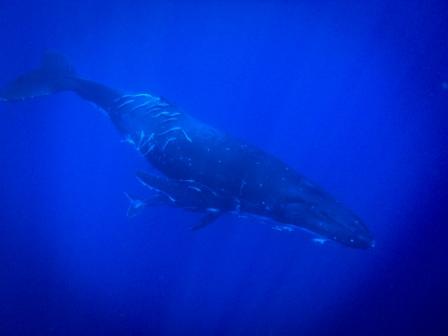Whalewatching

VulcanSpirit
Richard & Alison Brunstrom
Sun 16 Sep 2012 18:49
|
One of the reasons we came to Tonga was to go
whalewatching again. The population of humpbacks here has rebounded after the
cessation of whaling - there are now about 800-1000 animals in the Tongan
breeding population, up from perhaps 20 females left when the Russians
eventually stopped whaling here thirty years or so ago.
The humpbacks feed in the Antarctic during the
summer, and come to mate and give birth in the warm shallow sheltered water of
the Tonga archipelago. A calf is born, weighing about 2 tonnes and measuring
about 2m, after eleven months' gestation. The females give birth in deep water
offshore (being mammals there is a placenta, an enormous placenta which
would attract predators) and then the mother and baby move immediately into the
shallow protected island waters for about 2-3 months before they set off
together for the south.
And here in Tonga one can swim with the whales.
Disappointingly the Tongan government has not passed any conservation
legislation despite whalewatching being their prime source of tourists, but the
local tour operators (almost entirely expats, as sadly usual in Polynesia) are a
fairly responsible bunch and they have drawn up a pretty good voluntary Code of
Conduct to prevent the whales being harrassed. Clearly it is working - the
whales could go somewhere else if they wanted to, but they have stayed here, in
rapidly increasing numbers.
Here is a female (20m long, 50 tonnes!) with her
new calf (about 4 weeks old) just visible under her pectoral fin. You can see
that she has a good shoal of remoras attached to her. These are not like
leeches; they have a sucking disc on the top of their heads which they use to
attach themselves for a free ride, but they are not parasites - they feed on
scraps left by the whale. There are two (only) species of remora, but I have no
idea which these are
 And here they are, closer:
 The calf has bad scarring on his face and below his
eye, and the white patch above his fin is an open wound. It seems likely that an
adult male, displaying to the cow by breeching, has fallen onto him
scratching him with the very sharp barnacles that adorn the adults. But the calf
is recovering and should have no lasting injuries.
That's the end of our swimming with whales - after
we leave here there is nowhere else to do it.
|